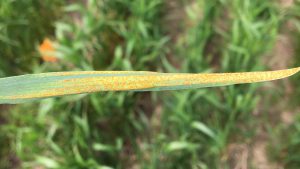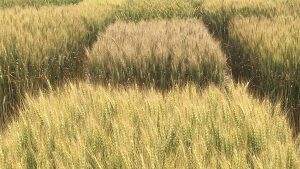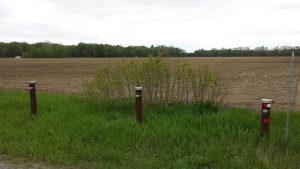Cropside: Managing stripe rust
AGRONOMIC INFORMATION FROM ONTARIO'S CROP SPECIALISTS

IN 2016, THE milder winter conditions resulted in early leaf and stripe rust infections in Tennessee and Kentucky. This resulted in rust spores being blown into Ontario earlier than we typically see. By mid-May 2016, stripe rust was prevalent in most areas of southwestern Ontario. Farmers who selected tolerant varieties or applied a foliar fungicide were able to keep the disease at bay. However, farmers that selected susceptible varieties and did not apply a foliar fungicide saw significant yield reductions. In 2017, stripe rust again arrived early in southwestern Ontario being found in one field in Essex County the first week of May. Although we have not historically seen stripe rust at significant levels in Ontario in the past, it is important to have a plan in place in 2018 for managing this disease.
The optimal temperatures for stripe rust development are 10°C — 15°C with periods of high relative humidity; but as we observed in Ontario, stripe rust can develop at higher temperatures. Windy days will also help with spore dispersion. Stripe rust causes yellow to orange, blister-like lesions that are arranged in stripes on the leaf of the wheat plant (Figure 1). If left untreated, stripe rust can cause significant yield reductions. In 2016 and 2017, where farmers had a high incidence of stripe rust not controlled through appropriate variety selection or fungicide application, yields were reported to be as low as 45 bu/ac.

INTEGRATED STRIPE RUST MANAGEMENT
The best defence against stripe rust is a combination of variety selection, scouting, and timely fungicide applications. In Ontario winter wheat varieties, there are large differences in variety susceptibility to the disease. Farmers should check with their seed supplier and the Ontario OCCC performance trials for specific variety ratings (www.gocereals.ca). If a variety has a rating of 6 or higher the variety is susceptible to stripe rust and will benefit from a fungicide application if stripe rust is present. If a variety is rated 3 to 5 than it is considered moderately resistant and should be scouted for stripe rust regularly during the growing season. If stripe rust is present and appears to be challenging the upper leaves of the canopy in these moderately resistant varieties that is when you may want to consider a fungicide application, particularly if the wheat is just at flag leaf. As we saw in 2017, some growers got caught with a severe disease infestation 10 days before that T3 fungicide application and had significant yield losses as a result. However, if stripe rust incidence and severity was low on these tolerant varieties and growers were less than a week away from fusarium fungicide timing then they were able to wait. If a variety in your area has a rating less than 2 than this indicates that the variety is resistant against stripe rust and will likely not benefit from an early season fungicide application.

Spring may seem like a ways away, but as we move into the 2018 growing season, scout fields early, particularly when disease is being detected early in the season in neighbouring U.S. states. Regular scouting assists in determining if fungal disease infection is progressing up the plant and is critical in determining if a fungicide application is needed and at what timing. A lot depends on the level of infection, environmental conditions, and crop susceptibility but by selecting resistant varieties and with regular crop scouting this disease can be managed effectively.
Written with contribution from Albert Tenuta, Field Crop Plant Pathologist, Ontario Ministry of Agriculture, Food and Rural Affairs. •

























